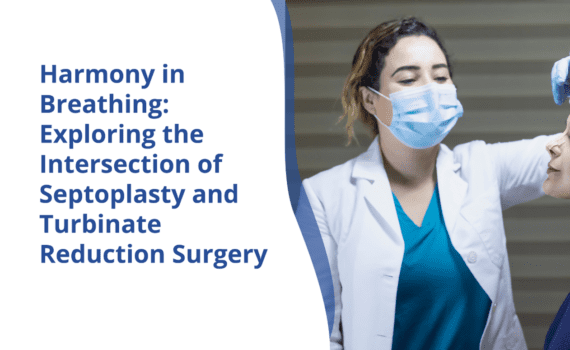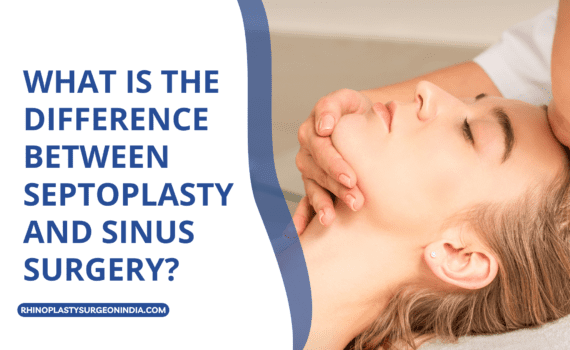
Harmony in Breathing: Exploring the Intersection of Septoplasty and Turbinate Reduction Surgery
You are not alone if you have trouble breathing through your nose or feel congested. About 80% of the world’s population has the same problem, and the reason for that is the deviated septum and enlarged turbinates caused by it. The septum and turbinates are the two most essential components of the nose that ensure regular and comfortable airflow.
Septoplasty in India is often combined with turbinate reduction surgery to make breathing easier and relieve various issues, such as chronic congestion, sleep apnea, recurrent and chronic sinus infections, nosebleeds, and facial pain. Let us first examine the functions of the septum and turbinates.
What is the septum?
The septum is a thin wall-like structure made of cartilage in the front and bone at the back, and it is covered with mucosa (like the inner lining of your cheek). The septum wall separates the left and right nostrils of the nose. The septum plays a vital role of
- maintaining the shape of the nose
- ensuring a regular airway.
- Protect the nasal structures from trauma
- Olfaction, which allows us to perceive and distinguish the various smells
The septum can be bent or deviated because of many reasons, such as trauma, accident, or hereditary reasons, and lead to breathing issues coupled with facial pain, congestion, post nasal drip, snoring, etc.
What are turbinates?
The turbinates are very tiny cone-shaped bones inside the nose. They are also called nasal conchae. They are curled structures that are bony as well as spongy. They are covered with hair-like structures called cilia that trap the external particles. There are three types of turbinates – inferior, middle, and superior. They play a super important role in regulating airflow for the lungs to work efficiently and also
- Warm and moisten the air we breathe to ensure it is at body temperature as it reaches the lungs.
- Keep out the debris and bacteria from the nose and enter the lungs and body.
- Prevent nasal dryness, infection, and irritation.
- Help us smell.
The turbinates can change in size to control airflow. When we are resting, the turbinates often swell to reduce airflow, and when we are involved in strenuous activities, they constrict to increase the airflow volume in the lungs. The inferior turbinates become inflamed and enlarged because of allergies or other conditions, resulting in blocked airways in the nasal passage and difficulty breathing.
The symptoms of enlarged turbinates are similar to those of a deviated septum, such as chronic sinusitis, nasal congestions, difficulty in breathing, frequent headaches, sleep apnoea, mucus production, and more.
The relation between deviated septum and turbinates is significant.
- A deviated septum reduces the size of one side of the nostril, causing an imbalance in the airflow in the nasal passages. The turbinates on the other end of the uneven airflow swell and become inflamed to compensate for and balance it. If the septum is deviated to the left, then the turbinates on the right will become inflamed. This causes turbinate hypertrophy, where the turbinates are swollen and congested.
- A deviated septum also causes nasal obstruction and airflow resistance, further contributing to the turbinates’ swelling and congestion.
The combination of deviated septum and inflamed turbinates also increases the risk of chronic sinusitis. The swollen turbinates obstruct mucus drainage, causing repeated sinus infections and disruptions in daily life. This also exacerbates snoring, sleep apnoea, and sleep disturbances, leading to daytime fatigue and cognitive impairment.
Septoplasty with turbinate reduction surgery (rhinoplasty)
Depending on the severity of symptoms and individual patient factors, the surgeon will recommend a rhinoplasty and deviated septum surgery in India.
Septoplasty Procedure
Septoplasty, or deviated septum surgery in India, corrects the crooked septum.
- It is a surgical procedure done under general anesthesia.
- An incision is made inside the nose, and the surgeon will lift the membrane covering the septum.
- The septum (excess cartilage removal or bone trimming) is modified for necessary straightening.
- Once satisfied with the reshaping. The surgeon will reposition the membrane to cover the septum and close the incisions using dissolvable stitches.
- The process takes 30 to 90 minutes, and no visible scarring exists.
Turbinate Reduction Surgery
The rhinoplasty can be quickly done along with septoplasty surgery to reduce nasal obstruction. There are two types of Rhinoplasty.
- Intraturbinoplasty is when the surgeon creates a tunnel inside the turbinate and removes the submucosal tissue.
- Extraturbinoplasty is the surgery to reposition the turbinate and clear the airway obstructions.
Turbinoplasty Techniques Used
Microdebrider rhinoplasty or turbinate resection: The surgeon creates a small incision inside the turbinate. Then, using a small endoscopic camera and a high-speed device called the Microdebrider, the surgeon will remove a partial portion or all of the tissues inside the turbinates and suction them out. The outer layer remains intact. As the nose heals, the turbinates shrink naturally. This is an exact and effective procedure that is followed by septoplasty. It is a long-term turbinate reduction solution with the least side effects.
Turbinoplasty out fracture technique: This type of turbinate reduction is a surgical procedure done to reduce the size of nasal turbinates by repositioning them outwards. The incision is made inside the nose. The mucosal lining is lifted, and the bone is carefully fractured using a nasal bone spreader or bone scissors; the surgeon will then reposition the turbinate outwards, i.e., away from the nasal septum. The repositioned turbinate is secured using a dissolvable suture to prevent it from moving back to the septum. This process increases the space in the nasal airway and reduces obstruction.
Radiofrequency ablation: Radiofrequency turbinate reduction is done with the aid of an endoscope. The endoscope delivers radiofrequency energy to the inflamed turbinates. The heat from the energy creates lesions inside the turbinate tissues, leading to scar tissue formation. As the tissue heals, the turbinates reduce in size. This is a minimally invasive procedure. However, the turbinates can grow back over time.
Coblation: The CTR, or Coblation Turbinate Reduction, is like the radiofrequency reduction but has lower temperatures to avoid damaging the nearby tissues. The procedure removes or dissolves the turbinate tissue in a controlled manner. There is no damage to the surrounding tissues.
Cauterization: This turbinate reduction uses a heated probe to close off some of the turbinates’ blood vessels. This reduces the blood flow to the turbinates, which shrink naturally.
Partial resection: This procedure involves removing a small piece of the turbinate and hard and soft tissues.
Turbinate reduction surgery is quick and takes about 10 to 30 minutes to complete.
In India, Septoplasty and turbinate reduction have long-term results in reducing congestion, alleviating and eliminating snoring, and improving and stabilizing the nose’s structure and shape.
Recovery And Healing Post Rhinoplasty And Deviated Septum Treatment
Since both procedures are done together, it dramatically reduces the healing time, and septoplasty cost in India with turbinate reduction is less than paying for two procedures individually. Tips for quick and whole healing
- Do not disturb or try to move or remove the soft packing and splints placed post-surgery. These are necessary to hold the nasal tissue in place, reduce the scarring, and ensure good nasal shape.
- Stay away from driving for a few days after the operation.
- Avoid exercising, heavy lifting, and other activities that increase the blood pressure and heart rate. Increased breathing can put a strain on the sutures and cause extra bleeding, pain, and swelling.
- Take the medications as prescribed.
- For the first few months of healing, use the nasal saline douche (salt water) as directed by the surgeon.
Septoplasty Surgery Cost In India
The combined cost of septoplasty and turbinate reduction surgery (often performed together as a single procedure) in India can vary depending on several factors, including the location, the reputation and experience of the surgeon, the type of hospital or clinic, the specific techniques used, and any additional services or facilities provided.
These estimates often include surgeon’s fees, hospital charges, anesthesia fees, preoperative consultations, postoperative care, medications, and any additional tests or services required. The actual cost will vary depending on your condition, such as the severity of the obstruction, the type and complexity of the procedure, the healing treatments needed, the health of your skin, and other factors. Discuss with your insurance provider about insurance coverage of the cost of septoplasty surgery in India.
Remember that it is essential to prioritize safety, expertise, and patient satisfaction when selecting the clinic and surgeon for the best, longest-lasting, and safest results.
For More Details Contact Us Now!



